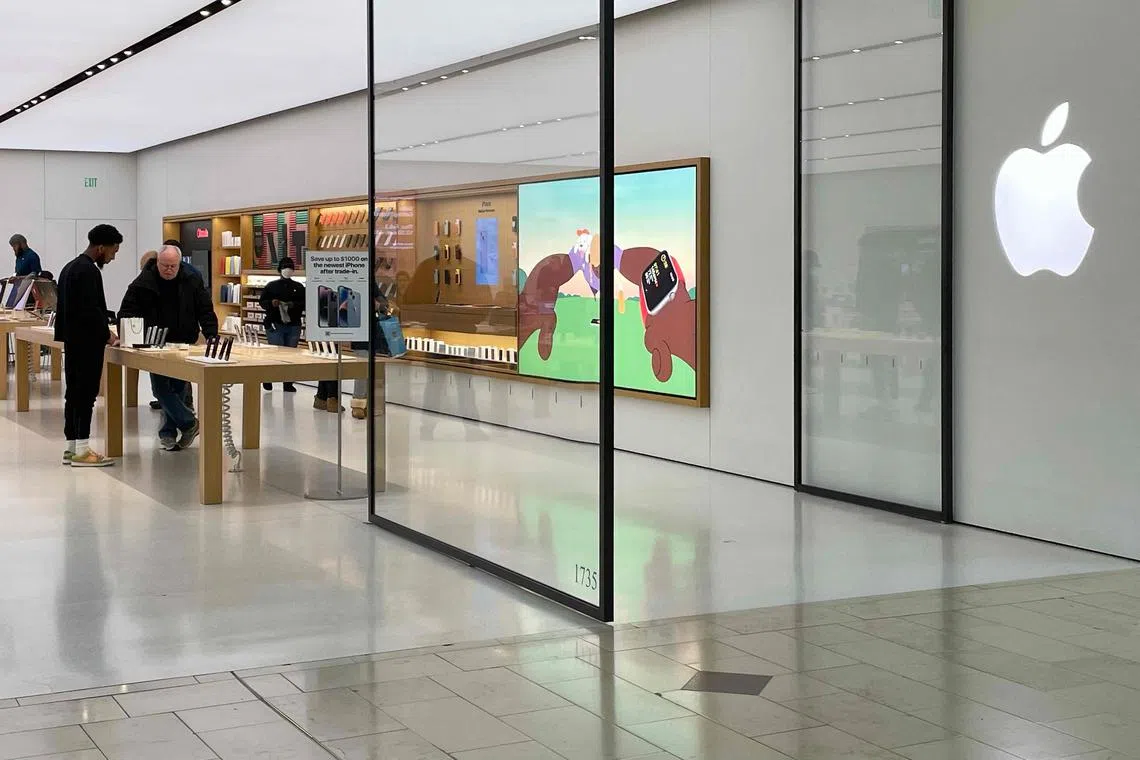Apple forecasts another revenue decline but sees iPhone sales improve as production returns
Sign up now: Get ST's newsletters delivered to your inbox

Apple’s profits missed Wall Street expectations for the first time since 2016, dragged down by iPhone sales falling for the first time since 2020.
PHOTO: AFP
Follow topic:
SAN FRANCISCO – Apple on Thursday forecast that revenue would fall for a second quarter in a row, but that iPhone sales were likely to improve as production had returned to normal in China after Covid-19-related shutdowns.
While striking an optimistic tone on sales of services and iPhones, Apple chief executive Tim Cook said an uncertain economy was expected to hurt categories such as gaming and digital advertising.
For the just-ended quarter, Apple’s profits missed Wall Street expectations for the first time since 2016, dragged down by iPhone sales falling for the first time since 2020.
Apple’s sales fell 5 per cent to US$117.2 billion (S$153.7 billion) and were down in every part of the world in the quarter. Sales from each product category dropped, except for gains in services and iPads. Earnings per share were US$1.88.
During its fiscal first quarter ended Dec 31, Apple faced a wave of challenges that left Wall Street expecting lower sales.
Chief among those were supply chain pressures when Covid-19 lockdowns at a production facility in Zhengzhou, China, slowed production of iPhone 14 Pro and Pro Max devices, both premium-priced models that would traditionally help drive Apple’s margins higher.
In an interview with Reuters, Mr Cook said that production disruptions “lasted through most of December” but that “production is now back where we want it to be”.
He said the lockdowns in China created a dual challenge where both supply and demand were constrained, with Greater China sales falling 7 per cent to US$23.9 billion.
The strong US dollar also hurt Apple, which derives more than half of its sales from outside the Americas, but the effect was less than anticipated as the dollar eased from last year’s highs.
Apple had warned investors that such foreign exchange issues would put a 10 per cent drag on sales but said on Thursday that the actual effect was 8 per cent. Apple expects a 5 per cent impact from foreign exchange rates in the fiscal second quarter.
“I would point out that 8 per cent is still a very severe headwind,” Mr Cook told Reuters. “I would not want to underestimate that. We would have grown on a constant currency basis.”
On top of supply chain problems for the iPhone, Wall Street analysts had expected iPhone sales to fall this year as part of a larger pattern in which the iPhone 14 family released last year sells more slowly after two straight years of strong sales of iPhone 12 and 13 models.
Apple said iPhone sales were US$65.8 billion, down 8 per cent from the year before and the first fall since 2020.
The company’s services segment, which includes content businesses such as Apple TV+ and software business like the App Store, rose 6 per cent to US$20.8 billion in revenue, in line with analyst expectations, according to Refinitiv data.
Mr Cook told Reuters that the company now has a base of two billion active devices, up from 1.8 billion a year ago.
The company now has 935 million paid subscriptions, up from 900 million the quarter before, and services sales set a record in several markets, including China, he said.
Sales of the company’s Mac computers, which had boomed during the wave of working from home during the pandemic, declined 29 per cent year on year to US$7.7 billion, compared with expectations of US$9.6 billion, according to Refinitiv data.
Apple executives had warned last year that Mac sales were likely to decline year on year because the previous year’s results included a burst of sales associated with the release of new MacBook Pro computers with Apple’s house-designed processors.
Sales of the iPad, which also saw a pandemic-related boost, grew 30 per cent to US$9.4 billion, compared with analyst expectations of US$7.8 billion, according to Refinitiv data.
The wearable and accessories segment, which includes the Apple Watch and AirPods, fell 8 per cent to US$13.5 billion compared with analyst estimates of US$15.2 billion, according to Refinitiv data.
Mr Cook told Reuters the iPad’s strong performance stemmed from the launch of new models and the absence of supply constraints that had hindered sales of the device a year earlier. REUTERS

